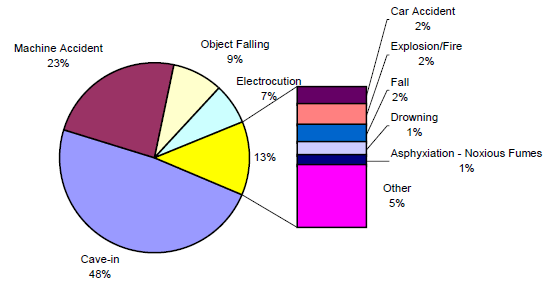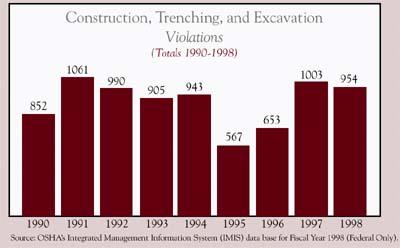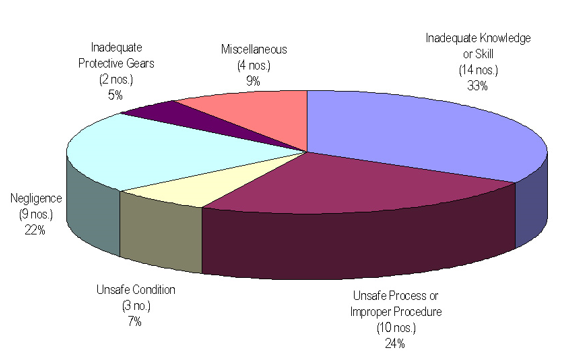Introduction
Background
Excavation is one of the most important aspects of construction. It is almost impossible to have a construction process that does not involve excavation, especially at the initial stages. However, Morgan (56) notes that many accidents and incidents have been reported at excavation sites in the recent times, making it necessary to investigate how the issue can be addressed. People have lost arms, fingers, eyes, and other parts of the body while working at the excavation sites.
Many have developed permanent disabilities at these sites because of these accidents. The unlucky victims have perished at such sites, the fact that is causing concern to the public in this country. It is a fact that construction processes will not come to a halt in the United States because of these accidents. Construction has to continue despite these accidents. For this to happen, we must have people working at the excavation sites.
Turner (42) says that in order to have people working at these sites, it is important to have measures that will ensure they are protected from these accidents. The government of the United States has come up with measures that are meant to ensure that workers at the excavation sites are protected by the law. Through the Department of Labor, the government came up with the Occupational Safety and Health Administration (OSHA) as an institution that sets and implements the occupational safety issues at places such as the excavation sites. In this case study, the researcher will examine why excavation sites are considered problematic in construction.
Research questions
When conducting a study, research questions play a very important role. They define the kind of data a researcher will be looking for in the field. Research questions help to define the data which is specifically needed to address various parts of the study. This way, a researcher will not waste time collecting the data that is irrelevant to the research topic. In this study, the following is the main research question in this study.
- Why are excavations a problem in construction?
As stated above, the primary concern for the researcher is to determine why excavations are posing serious problems in the construction industry. In order to respond to this question, the researcher developed the following supportive questions to help in the actual process of collecting data.
- How many workers die every year at excavation sites?
- What does OSHA say about the excavations?
- What are the standards and how are they enforced?
- What do workers need to know?
The researcher will use these questions to collect data from literatures in order to determine why excavation is still considered a major problem in the construction industry despite its importance.
The Credibility of Information Sources
When conducting a research, the issue of credibility is always very critical. As Morgan (113) says, research reports play an important role in enhancing the existing body of languages. Future researchers may rely on such a report as a basis to further their studies. Policy makers may use such reports to inform their decisions on issues under investigation. This means that credibility of such reports should be unquestionable. This field of occupational safety is very important.
It is an issue of life or death to the people who are affected. This means that extra care should be taken to ensure that the report is very accurate, reliable, and contains the facts that can be verified. That is why the researcher was keen on selecting reliable sources when developing this report. The case used on this study was taken from the United States Department of Labor, in its OSHA reports. The case was widely reported by some of the reputable media stations in this country.
It has been in the public domain for some time, making it a very reliable source. The researcher collected information about safety laws and regulations from OSHA website, the body that is responsible for developing the rules and regulations about occupational safety standards. The other additional materials collected to support the study were taken from the peer reviewed sources. These measures were taken to ensure that the report compiled is credible and can be used by the policy makers to inform their decisions.
The Case
The United States’ Department of Labor conducted an investigation on August 2014 on Angel Brothers Enterprise Limited to ascertain the complaints about non-compliance with the OSHA rules and regulations. Angel Brothers Enterprises Limited is a company that provides different kinds of underground utility constructions (Morgan, 2014). The department had received complaints from members of the public and some workers that the management of this firm had failed to take into consideration issues regarding the safety of their workers.
Although at the moment no incidents or accidents had been reported at their Baytown excavation sites in Texas, there were concerns that anything could happen and this may lead to serious injuries or even loss of lives. This authority, having witnessed cases where people have died or injured because of the negligence of the employer, commenced an investigation to ascertain the claims. The investigation identified three major violations of occupational safety laws and regulations that posed a serious danger to the employees working at this firm. These three violations include:
- The equipment and other materials were not kept at least two feet from the excavation edges.
- The accumulated water inside the trenches, that weakens the stability of the sites, was not removed.
- The company had failed to affix identifications to the alloy chain slings meant for lifting size and capacity.
According to OSHA’s area director, Mr. Mark Briggs, Angel Brothers Enterprise Limited had a history of ignoring the need to protect its employees. The top managers of the firm knew about the accumulated waters in their trenches and the threat this would pose to their employees, but no action was taken. The OSHA area director said that given the fact that a serious accident was yet to occur at these sites, the inability of the managing directors to act was a sign that they were ignoring the law and the well being of their employees.
These sites were actually death traps, and the early intervention that had been made by the responsible citizens who reported the issue to the authority was a proactive move that saved lives of many. The Department of Labor, through its OSHA unit, fined the company a penalty of $ 89,500 and an ultimatum of 15 days to comply with the law as per the weaknesses identified, failure of which the firm would be closed down.
Discussion
The construction industry is increasingly becoming very important in the United States of America. People are building new homes and recreational facilities. Business entities are constructing new offices, retail outlets, and stores. The government is constructing new schools, hospitals, and roads among other infrastructures. All these construction processes require some form of excavation, either to prepare the construction sites or to get the materials needed for the construction. However, it is worrying that most of the excavation processes have become very dangerous to the workers and even members of the public. In this section, the researcher will focus on investigating why excavations still pose serious threats to the users and the measures that can be taken to address these threats.
Reasons that make excavations a problem in the construction industry
According to the regular annual statistics released by the department of labor regarding accidents taking place at the excavation sites, it is evident that this sector poses serious problems that need to be addressed by the relevant stakeholders. The figure below shows some of the common causes of deaths and injuries at the excavation sites.

According to this report, it is evident from the statistics above that cave-in is the leading cause of deaths and accidents in excavation sites. When the safety standards and procedures are not correctly followed, these sites can easily cave in, and when this happens, those trapped inside would always be buried alive. This is one of the most painful deaths that many workers at such sites have faced. It is very common when the trenches have accumulated water that weakens the walls.
Machine accidents are another cause of accidents that lead to serious injuries or even death. When a person with limited knowledge on how to operate the machines is allowed to work at such sites, it is very easy for him to harm himself or his fellow workers. Sometimes the machine may be faulty, making it impossible to ensure that they follow the right commands at all times. Falling objects and electrocutions are other major problems at the excavation sites. Other less common causes of deaths or serious injuries include explosions, fall, drowning, noxious fumes, and car accidents, among others.
According to the report by Morgan (47), it is worrying that many companies have failed to observe the rules and regulations regarding the management of excavation sites. This is one of the reasons why these accidents continue to occur despite the effort of the government to ensure that the employees are protected. The following figure shows the reported cases of violation of construction, trenching, and excavation rules and regulations as set by the government.

As shown in the figure above, there was a significant rise in the violations of the rules between 1990 and 1991. However, this figure dropped till 1995 when the least cases of violations were reported. From 1996 to 1998, the number of reported cases increased. This means that there has been inconsistency on the part of the private companies when it comes to observing the law. Periods when the government engaged in regular crackdowns against the people who do not obey the law records least possible cases of accidents. However, when these entities are allowed to be responsible in terms of following the laws and regulations, then they fail to do so, making it necessary for the government to do follow-ups.
The researcher was interested in determining the role of employees in the accidents that occur at the excavation sites. It is true that the top managers bear the largest portion of the blame. However, it is only fair to look at the role played by the employees in order to come up with a comprehensive report on the role of various stakeholders when addressing these problems.

Inadequate knowledge or skills was cited as the major cause of accidents among the employees at the construction sites. These employees end up issuing wrong commands to the machines, resulting into accidents. Another major cause of accidents in relation to the employees is the use of unsafe process or improper procedure. This is caused by the desire to use shortcuts to achieve the expected outcome or in some cases it is simply an issue of ignorance. Negligence, unsafe conditions, and inadequate protective gears were cited as other reasons causing accidents at such sites.
The number of workers who die every year at excavations sites
The researcher was interested in getting the right statistics about the number of people who die due to issues such as the collapse of the construction sites. This would help in determining whether we are making a positive progress in combating this problem. The following data was obtained to help in understanding the trend.

Within the three years that the evaluation was done, the year 2003 registered the worst cases of excavation and trenching accidents. There were a total of 310 non-fatal injuries and 48 fatal injuries. This figure reduced significantly in 2004 when 100 non-fatal and 41 fatal injuries were recorded. However, in 2005, the number increased to 120 non-fatal and 44 fatal injuries. This inconsistency, which has been discussed in the section above, is one of the greatest challenges in addressing the excavation problem.
OSHA’s rules and regulations regarding excavations
OSHA has enacted laws and regulations to help in guiding the operations of all the companies operating in the construction sector, including those that specialize in excavations. This body is responsible for protecting the rights of the employees by ensuring that all laws concerning occupational health and safety are adhered to by this firm. The regulations start by defining the machine operations rules and regulations.
It defines who should operate the machines, how the machines should be operated and issues about maintenance. Under this rule, all the employers have the responsibility to ensure that the machines are only operated by those individuals that have the relevant skills, within the specified period, and for undertaking a specific activity. Each activity in the excavation process has specific standards that they must meet before they can be taken to the field to conduct various activities. These tools and equipment must be maintained in good condition in order to ensure that they do not malfunction when they are under operation.
The management is also responsible for replacing these tools and equipment on a regular basis. OSHA defines safeguard standards on how the employees should dress while at work. It also states the trainings that employees should undertake before allowing them to undertake various duties. Maintenance of the construction sites, including placement of various tools and equipment is also defined by this body.
Standards and how they are enforced
Setting the standards as stated in the section above is just one step towards ensuring that the employees are safe while they are working at the construction sites. However, it is very important to ensure that these standards are enforced. OSHA has the powers to investigate the deviations from the law and issue penalties to the firms in this country. The investigation can be done following complaints from the workers or members of the public, as was the case with Angel Brothers Enterprises Limited. OSHA also has a mandate to conduct regular checks at the excavation sites of various companies in the country using its regional offices.
Information that the workers need to know
It is important for the employees to know the specific issues concerning their safety while working at the excavation sites. The first information is how to operate various machines and equipment. They have to know the skills they should have and any other relevant information regarding machine operation. They should know how to wear protective gears when they are at the excavation sites. Knowledge about safety precautions and how to avoid accidents is also critical. OSHA rules and regulations also require the employers to ensure that their employees know how to sound alarms or call for help when under any threat.
Conclusion
Recent statistics show that many lives are lost in excavation sites within the country, the fact that is affecting the construction industry. The major cause of these accidents is negligence by the company administrators to abide by the set laws concerning occupational therapy. The case study about Angel Brothers Enterprises Ltd reveals that many firms have ignored the basic safety needs for their employees and people who may visit these sites. OSHA should conduct regular inspections at these sites and issue stiffer penalties to those bending the law.
Works Cited
Moran, George. Construction safety handbook: A practical guide to OSHA compliance and injury prevention. Rockville: ABS Consulting, Government Institutes, 2013. Print.
Morgan, Charles. Excavation safety: A guide to OSHA compliance and injury prevention. Rockville: ABS Consulting, Government Institutes, 2015. Print.
Turner, James. Excavation systems: Planning, design, and safety. New York: McGraw-Hill, 2010. Print.